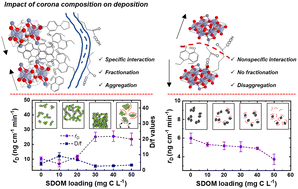Dissolved organic matter regulates aggregation and deposition of chromium (hydr)oxide colloids: molecular-scale investigation using ESI-FT-ICR-MS†
Abstract
Soil dissolved organic matter (SDOM) forms the corona and affects the colloidal mobility of Cr (hydr)oxides. Such processes are important in evaluating Cr immobilization effectiveness. This study for the first time found that the SDOM composition instead of electrostatic interactions accounted for the significant differences in the aggregation and deposition kinetics of short-range-order Cr(OH)3 Cr(OH)3 and crystalline Cr2O3. The molecular-scale composition of SDOM associated with Cr (hydr)oxides was investigated using Fourier transform-ion cyclotron resonance-mass spectrometry (FT-ICR-MS) and Fourier transform-infrared spectroscopy (FT-IR). Low molecular-weight aromatic compounds with multiple carboxyl groups and amphiphilic segments preferentially associated with Cr(OH)3, whereas Cr2O3 mainly adsorbed high molecular-weight hydrophobic compounds. The molecular composition of SDOM associated with colloids depended on the singly coordinated hydroxyl content of Cr (hydr)oxides. The aggregation and deposition of Cr(OH)3 significantly increased with increasing SDOM loading due to the formation of more thermodynamically stable coprecipitates in solution or on the silica surface via bridging of carboxylates. A secondary zonal layer on Cr(OH)3 inhibited the coprecipitation of Cr(OH)3 with SDOM under a high SDOM loading. In contrast, the aggregation and deposition of Cr2O3 decreased with increasing SDOM loading due to the steric hindrance of hydrophobic compounds. This study highlighted the importance of corona composition in assessing the potential mobility of Cr (hydr)oxides and the stability of immobilized Cr species.

- This article is part of the themed collection: Environmental Science: Nano Recent HOT Articles


 Please wait while we load your content...
Please wait while we load your content...